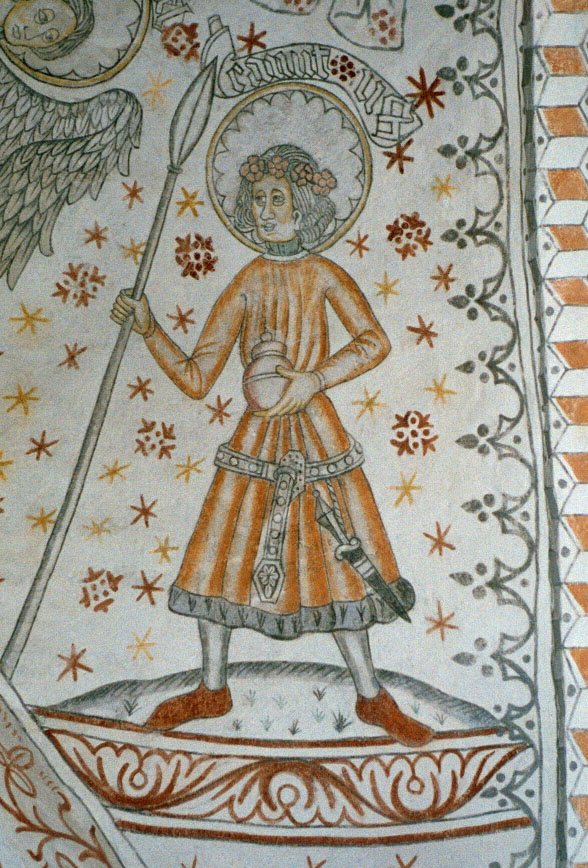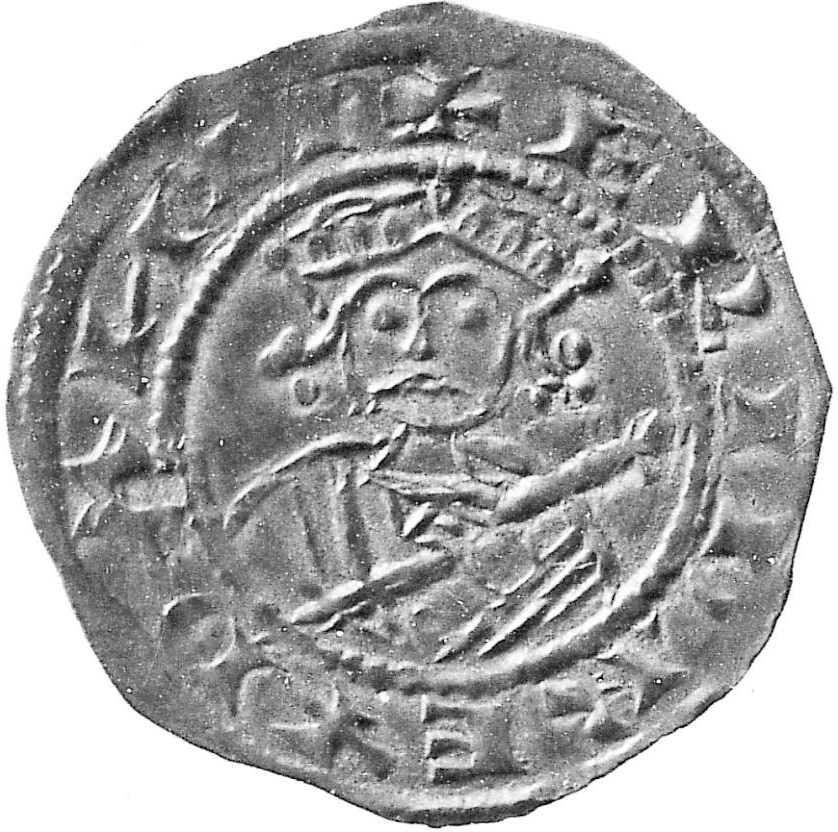by Susan Flantzer
© Unofficial Royalty 2025
Coin of King Eric I, depicting his image; Credit – Wikipedia
Born circa 1056 in Slangerup, Denmark, Eric I, King of Denmark (also known as Eric the Good), from 1095 to 1103, was the fourth of five illegitimate sons of Sweyn II Estridsson, King of Denmark to become King of Denmark. Eric’s father Sweyn II married twice. His first marriage was childless. According to the chronicle “Jerusalem History”, Sweyn the Crusader, the legitimate son of a King of Denmark, took part in the First Crusade, dying in battle in 1097. Some researchers believe that he was the son of Sweyn II from his second marriage, but there is no documentary evidence of the existence of Sweyn the Crusader. Sweyn the Crusader would have been living when Sweyn II died in 1076. It would seem logical that a legitimate son of Sweyn II would have been considered a candidate to be his successor. However, only his illegitimate sons Harald III, Sweyn II’s successor, and Cnut IV, who succeeded Harald III, were considered.

Portrait of King Sweyn II that marks his place of burial in Roskilde Cathedral; Credit – Wikipedia
Sweyn II had many mistresses and fathered at least twenty children. The identity of the mothers of his illegitimate children is uncertain. Sweyn II’s illegitimate children listed below are either Eric’s full siblings or half-siblings. “Brother” will be used when discussing Eric’s male siblings but it is unknown whether they were full brothers or half-brothers.
Eric married Bodil Thrugotsdatter (circa 1056 – 1103 ), the daughter of Thrugot Ulfsen Fagerskind, a Danish earl and nobleman from Jutland, Denmark, and Thorgunna Vagnsdatter. It is believed they married before 1086 because it is documented that Eric and Bodil lived in exile in Sweden during the reign of Eric’s brother Olaf I, King of Denmark, who reigned from 1086 to 1095.

Saint Canute Lavard, Eric and Bodil’s son; Credit – Wikipedia
Eric I and Bodil had one son:
In 1115, King Niels of Denmark, the successor and brother of King Eric I, created his nephew Cnut Lavard, Earl of Schleswig. Cnut Lavard used the title Earl of Schleswig for only a short time before he began to style himself Duke of Schleswig. He was the first of many Dukes of Schleswig, and the first border prince who was both a Danish and a German vassal. In 1131, Cnut Lavard was killed by his cousin Magnus the Strong who saw him as a rival to the Danish throne. Cnut Lavard was canonized as a saint by the Roman Catholic Church in 1170.
Eric I had an illegitimate son with an unknown concubine who was a King of Denmark:
- Eric II, King of Denmark (circa 1090 – 1137), married Malmfred of Kiev, no children; with his concubine Thunna, Eric II had a son, Sweyn III, King of Denmark
Eric I had several other children born out of wedlock:
- Harald Kesja (1080 – 1135), married Ragnild Magnusdotter, daughter of King Magnus III of Norway, had six legitimate children and nine illegitimate children. Harald Kesja and his eight surviving sons were beheaded after their defeat at the Battle of Fotevik during a civil war for control of the Danish throne.
- Benedict
- Ragnhilde, married Haakon Sunnivason, mother of King Eric III Lamb of Denmark
On July 10, 1086, Eric’s brothers (Saint) Cnut IV, King of Denmark and Benedikt, and seventeen of their followers, trying to escape from rebels, took refuge in the wooden, Viking Age St. Alban’s Priory Church (link in Danish) at St. Alban’s Priory in Odense. The rebels stormed into the church and killed Cnut IV, his brother Benedikt, and their seventeen followers before the altar. Eric had been with his brothers but remained at the royal farm instead of accompanying them to St. Alban’s Priory.
During his reign, King Cnut IV blamed his brother Olaf for stirring up trouble, and Olaf was imprisoned by their brother Eric. Olaf was then banished to Flanders, under the supervision of Robert I, Count of Flanders, Cnut IV’s father-in-law. After Cnut IV died, Olaf, still imprisoned in Flanders, was proclaimed King of Denmark. An arrangement was made to exchange Olaf for his younger brother Niels, a future King of Denmark. When Olaf returned to Denmark as King Olaf I, his brother Eric fled to Scania, now in Sweden, fearing Olaf’s revenge for his support of King Cnut IV.
During the reign of King Olaf I, Denmark suffered from crop failure, and Olaf was given the nickname “Hunger”. The crop failure was seen as divine retribution for King Cnut IV’s murder. King Olaf I died on August 18, 1095, aged about 45, under uncertain circumstances, and Eric was elected as King of Denmark. Eric was well-liked by the Danish people and the famines that had plagued Denmark during King I’s Olaf reign ceased. For the Danes, it was a sign from God that Eric was the right king for Denmark. In 1101, Erik participated in a meeting of the Three Kings in what is now Kungälv, Sweden, where King Magnus III Olafson of Norway, King Inge of Sweden, and King Eric I concluded a peace treaty. King Eric I is known by the nickname “the Good”, probably because the food supply and living conditions improved during his reign.
In 1101, Eric visited Pope Paschal II in Rome. He promoted the cause of sainthood for his brother King Cnut IV and Pope Paschal II agreed to canonize Cnut as a saint in the Roman Catholic Church. At the same time, Eric obtained an Archbishop in Denmark instead of Denmark being under the Archbishop of Hamburg-Bremen. Bishop Asser Thorkilsson then became the first Archbishop of Lund. Lund has been in Sweden since the Treaty of Roskilde in 1658, and the Diocese of Lund is now one of thirteen dioceses in the Lutheran Church of Sweden.

Painting by Danish history painter Niels Anker Lund (1840 – 1922) depicting the uproar caused when King Eric announced his decision to go to the Holy Land; Credit – Wikipedia
Shortly afterward, King Eric I announced that he would go on a pilgrimage to the Holy Land. According to the Danish Chronicles by Danish historian and theologian Saxo Grammaticus, Eric felt he needed to make the pilgrimage because he was guilty about murdering four of his own men while he was drunk at a feast in his own hall. Despite many pleas not to go, Eric was not deterred from making the long journey. Eric appointed his son Harald Kesja and Asser Thorkilsson, Archbishop of Lund, to act as regents in his absence.

A memorial to Eric I, King of Denmark in Paphos, Cyprus, where he died; Credit – Von Lcw27 – Eigenes Werk, CC BY 3.0, https://commons.wikimedia.org/w/index.php?curid=9939587
King Eric I and his wife Bodil traveled with a large entourage via Novgorod, Russia to Constantinople, then the capital of the Byzantine Empire, now the city of Istanbul in Turkey. In Constantinople, Eric and Bodil were received by the Byzantine Emperor Alexios I Komnenos. However, Eric never made it to the Holy Land. While in Constantinople, Eric became ill and despite his illness, he continued his travels by sea. King Eric I of Denmark died on July 10, 1103, in Paphos, Cyprus, where his wife had him buried. However, the location of his grave is no longer known. After Eric died, Bodil continued the journey and reached Jerusalem later in 1103. She died in Jerusalem that same year and was buried on the Mount of Olives or at its foot in the Valley of Josaphat.
This article is the intellectual property of Unofficial Royalty and is NOT TO BE COPIED, EDITED, OR POSTED IN ANY FORM ON ANOTHER WEBSITE under any circumstances. It is permissible to use a link that directs to Unofficial Royalty.
Works Cited
- Autoren der Wikimedia-Projekte. (2005). König von Dänemark. Wikipedia.org; Wikimedia Foundation, Inc. https://de.wikipedia.org/wiki/Erik_I._(D%C3%A4nemark)
- Bidragsydere til Wikimedia-projekter. (2002). Konge af Danmark (1059-1103). Wikipedia.org; Wikimedia Foundation, Inc. https://da.wikipedia.org/wiki/Erik_Ejegod
- Erik Ejegod – heimskringla.no. (2025). Heimskringla.no. https://heimskringla.no/wiki/Erik_Ejegod
- Flantzer, Susan. (2025). Sweyn II Estridsson, King of Denmark. Unofficial Royalty. https://www.unofficialroyalty.com/sweyn-ii-estridsson-king-of-denmark/
- Wikipedia Contributors. (2025). Boedil Thurgotsdatter. Wikipedia; Wikimedia Foundation.
- Wikipedia Contributors. (2025). Canute Lavard. Wikipedia; Wikimedia Foundation.
- Wikipedia Contributors. (2025). Eric I of Denmark. Wikipedia; Wikimedia Foundation.


